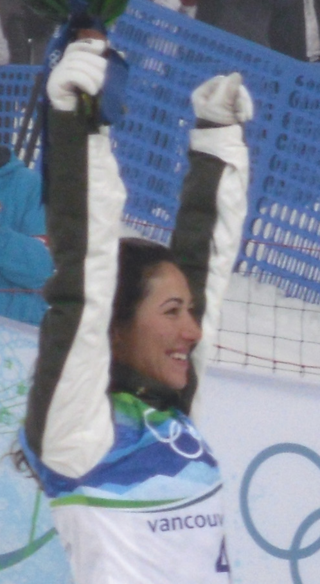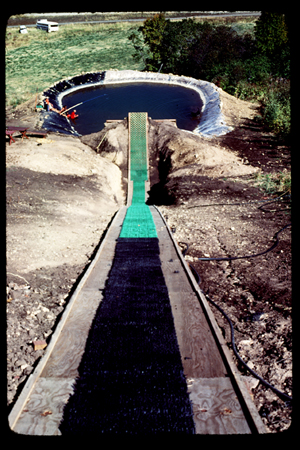
Ski jumping is a winter sport in which competitors aim to achieve the farthest jump after sliding down on their skis from a specially designed curved ramp. Along with jump length, competitor's aerial style and other factors also affect the final score. Ski jumping was first contested in Norway in the late 19th century, and later spread through Europe and North America in the early 20th century. Along with cross-country skiing, it constitutes the traditional group of Nordic skiing disciplines.
Freestyle skiing is a skiing discipline comprising aerials, moguls, cross, half-pipe, slopestyle and big air as part of the Winter Olympics. It can consist of a skier performing aerial flips and spins and can include skiers sliding rails and boxes on their skis. Known as "hot-dogging" in the early 1970s, it is also commonly referred to as freeskiing, jibbing, as well as many other names, around the world.

Ski flying is a winter sport discipline derived from ski jumping, in which much greater distances can be achieved. It is a form of competitive individual Nordic skiing where athletes descend at high speed along a specially designed takeoff ramp using skis only; jump from the end of it with as much power as they can generate; then glide – or 'fly' – as far as possible down a steeply sloped hill; and ultimately land within a target zone in a stable manner. Points are awarded for distance and stylistic merit by five judges. Events are governed by the International Ski Federation.

Lydia Lassila is an Australian Olympic freestyle skier gold medalist who competed in the 2002, 2006, 2010, 2014 and 2018 Winter Olympic Games. She is the 2010 Olympic champion and the 2014 bronze medalist in aerials.

Slopestyle is a winter sport in which athletes ski or snowboard down a course including a variety of obstacles including rails, jumps and other terrain park features. Points are scored for amplitude, originality and quality of tricks. The discipline has its roots in action sports like skateboarding and BMX and has very successfully crossed over into the snow sports worlds of skiing and snowboarding. Skiers use Twin-tip skis for their symmetry since they often go large portions of the course backward and for their balanced weight so as to not destabilize spins. Slopestyle tricks fall mainly into four categories: spins, grinds, grabs and flips, and most tricks done in competition are a combination of these.

Mogul skiing is a freestyle skiing competition consisting of one timed run of free skiing on a steep, heavily moguled course, stressing technical turns, aerial maneuvers and speed. Internationally, the sport is contested at the FIS Freestyle World Ski Championships, and at the Winter Olympic Games.

Aleksei Gennadyevich Grishin is a Belarusian freestyle skier who competed at five consecutive Olympics from 1998 to 2014. He won Belarus' only medal at the 2002 Winter Olympics, a bronze in aerials. In 2010, he won the first ever Winter Olympics gold medal for his country, again in the aerials. He finished fourth in 2006 and eighth in 1998. He was the Olympic flag bearer for Belarus at the opening ceremony of the 2014 Games.

David John Morris is an Australian aerial/freestyle skier who competed in 3 Winter Olympic Games in 2010, 2014 and 2018. He is Australia's most successful male aerial skier, having competed across FIS World Cup, World Championships and Winter Olympic competitions. He is the first Australian male aerial skier to compete at two consecutive Olympic Games, and the first Australian medalist in the Olympic Men's Aerials.

The Lake Placid Olympic Ski Jumping Complex, also known as the MacKenzie Intervale Ski Jumping Complex, consists of HS100- and HS128-meter ski jump towers built for the 1980 Olympic Games in Lake Placid, New York, United States. Modernized and lengthened in 2021, they are the only jumps in North America homologated for winter and summer jumping competitions. The complex is operated by the Olympic Regional Development Authority.

Water ramps into oversized pools, ponds, or lakes are constructed as training locations for aerial skiing, mogul skiing, and snowboarding acrobatics events. Such structures typically comprise three sections: in-run, a kicker, and a water surface for landing. They permit the practice of new skills with reduced risk, as the impact of a water landing is less dangerous than a comparable impact on compacted snow.

Kyle Nissen is a Canadian freestyle skier.
The men's normal hill individual ski jumping competition for the 2010 Winter Olympics in Vancouver, Canada was held on 12 and 13 February 2010 at Whistler Olympic Park in Whistler, British Columbia. It was the first medal event of the 2010 Games.
Ashley Caldwell is an American freestyle skier who has competed in aerials since 2008. Caldwell was named to the US team for the 2010 Winter Olympics in January 2010 after competing in the sport for only two seasons. The youngest in the event, she reached the finals of the Aerials. Caldwell won her first World Cup aerials event in the United States in Lake Placid, New York in January 2011, becoming the youngest freestyle female ever to win.

Xu Mengtao is an Olympic Champion Chinese aerial skier. She has 27 World Cup victories and an Olympic Gold. She is also the current World Cup leader and became the first Chinese woman to win an Olympic gold in the Aerial Ski event during her fourth Olympics at the age of 31. She was one of Team China's flag bearers, at the 2022 Beijing Winter Olympic's closing ceremony.
Ski ballet is a form of ballet performed on skis. It is very similar to figure skating, combining spins, jumps, and flips in a two-minute routine choreographed to music. It was part of the professional freestyle skiing tours of the 1970s and 1980s and then an official FIS and Olympic discipline until the year 2000. Ski ballet became known as Acroski in the 1990s in an effort to legitimize its place among the competitive ski community, especially to the FIS. It is no longer a part of competitive freestyle skiing.
Matt Chojnacki is a Freestyle Skiing Aerialist on the United States Ski Team from 1995 to 2001 and competed in Freestyle skiing at the 1998 Winter Olympics – Men's aerials. During that period he had six podium finishes, including one win, on the FIS Freestyle Skiing World Cup, and was the 1998 United States National Champion in Aerials.
Degree of difficulty is a concept used in several sports and other competitions to indicate the technical difficulty of a skill, performance, or course, often as a factor in scoring. Sports which incorporate a degree of difficulty in scoring include bouldering, cross-country skiing, diving, equestrianism, figure skating, freestyle skiing, gymnastics, rhythmic gymnastics, surfing, synchronized swimming and trampoline. Degree of difficulty is typically intended to be an objective measure, in sports whose scoring may also rely on subjective judgments of performance.
The men's aerials competition in freestyle skiing at the 2022 Winter Olympics was held on 15 February (qualification) and 16 February (final), at the Genting Snow Park in Zhangjiakou. Qi Guangpu of China won the event; this was his first Olympic gold medal. Oleksandr Abramenko of Ukraine, the defending champion, won the second medal, and Ilya Burov, representing the Russian Olympic Committee, won bronze, replicating his 2018 achievement.
The women's aerials competition in freestyle skiing at the 2022 Winter Olympics was held on 14 February at the Genting Snow Park in Zhangjiakou. Xu Mengtao of China won the event, which became her first Olympic gold medal. Hanna Huskova of Belarus won the silver medal, and Megan Nick of the United States bronze, also her first Olympic medal.











